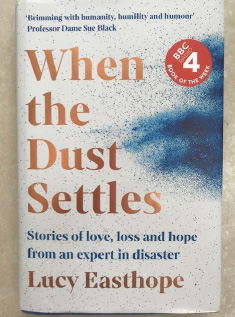 Author
Author
Lucy Easthope
Reviewed by
Anne Eyre, Centre for Collective Trauma, United Kingdom
Published by
Hodder & Stoughton
ISBN: 978-1-529-35824-7
This autobiography and memoir covers the author’s personal and professional experiences of emergency planning, response and recovery over more than 20 years. Lucy Easthope draws on her unique and varied roles in responding to events as wide-ranging as 9/11, the east Asian tsunami, the Iraq War, UK flooding, the Lac-Mégantic rail disaster, the Grenfell Tower fire and the COVID-19 pandemic.
The result is a fascinating and informative insight across all phases of disaster, from pandemic planning, disaster victim identification and mortality management, through to aftermath decision-making around, for example, personal effects and community engagement and into longer-term recovery journeys. For this reason, it is educational for anyone involved in emergency and disaster management, whatever their role, and offers the chance to see bigger pictures beyond the professional silos and situational awareness we sometimes inhabit.
The book has attracted interest and worthy praise among wider audiences too. It featured as a Book of the Week on UK BBC Radio 4 and has achieved Sunday Times best seller status.
Its appeal is not only its light, readable style and its subject matter; themes of love, accounts of loss and details of disaster all appeal, but they rarely feature alongside each other in quite the way as they do in this book.
The weaving of the personal and professional is intriguing and holds the reader’s attention throughout. Easthope’s accounts of the bizarre reality and dissonant emotions of being in emergency response mode (like being on a mobile phone at a social gathering or whispering in the corner at a child’s party) may chime with readers. If so, they may choose to share the book’s stories with those close to them for it gives others in our lives a rare opportunity to see in, to understand this hidden world and its effects on people who operate in the emergency and disaster fields. The book highlights the rippling and leaking impact of disaster work on responders’ families and friends. At the same time, a central theme is the importance of care and compassion for people directly affected since emergency management has consequences at some point for bereaved people, survivors and communities.
In a review for the New Statesmen, Dr Rowan Williams, former Archbishop of Canterbury, praised Easthope’s revelations about how the way we recover from disaster goes to the heart of what it means to be human. Indeed, a common theme throughout the book is the author’s ability to balance an honest presentation of the graphic realities of death and disaster with humanity, compassion, humour and hopefulness.
The experience of disaster is always deeply personal and dealing with multiple losses has enduring consequences. Easthope shares her family tapestries, hopes and dreams. It takes courage and humility to share one’s personal and emotional experiences so openly in the way she does.
What may resonate, especially for seasoned emergency managers, is not the grim reality of dealing with collective tragedy—this, we sadly know—but the painful familiarity of political and administrative ‘faff’ revealed in this account and the immense frustration of learned lessons that a lifetime in disaster management highlights. Easthope maintains her sense of hope and humour while coping with multiple experiences of being personally and professionally marginalised on various grounds over the years—her youth, her self-effacement, her academic status, her passion and her gender. This book leads one to ask, especially in extreme moments, why some instincts feel less palatable than others and why we allow some voices to be louder than others.


